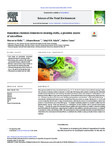Hazardous chemical elements in cleaning cloths, a potential source of microfibres
| dc.contributor.author | Filella, M | |
| dc.contributor.author | Brazard, J | |
| dc.contributor.author | Adachi, TBM | |
| dc.contributor.author | Turner, Andrew | |
| dc.date.accessioned | 2022-08-23T16:03:52Z | |
| dc.date.issued | 2022-11-10 | |
| dc.identifier.issn | 0048-9697 | |
| dc.identifier.issn | 1879-1026 | |
| dc.identifier.other | 157419 | |
| dc.identifier.uri | http://hdl.handle.net/10026.1/19557 | |
| dc.description.abstract |
Although potentially hazardous chemical elements (e.g., Cu, Cr, Pb, Sb, Ti, Zn) have been studied in clothing textiles, their presence in cleaning textiles is unknown. In this study, 48 cleaning cloth products (consisting of 81 individual samples) purchased in Europe, and consisting of synthetic (petroleum-based), semi-synthetic or natural fibres or combinations of these different types, have been analysed for 16 chemical elements by X-ray fluorescence (XRF) spectrometry. Titanium was detected in most cases (median and maximum concentrations ~3700 and 12,400 mg kg-1, respectively) and Raman microspectroscopy revealed that TiO2 was present as anatase. Barium, Br, Cr, Cu, Fe and Zn were frequently detected over a range of concentrations, reflecting the presence of various additives, and Sb was present at concentrations up to about 200 mg kg-1 in samples containing polyester as catalytic residue from the polymerisation process. Lead was detected as a contaminant in four samples and at concentrations below 10 mg kg-1. Overall, the range of the chemical element profiles and concentrations was similar to those for clothing materials published in the literature, suggesting that broadly the same additives, materials and processes are employed to manufacture cloths and clothing textiles. The mechanisms by which potentially hazardous chemical elements are released into the environment with microfibres or mobilised into soluble or nano-particulate forms remain to be explored. | |
| dc.format.extent | 157419-157419 | |
| dc.format.medium | Print-Electronic | |
| dc.language | en | |
| dc.language.iso | eng | |
| dc.publisher | Elsevier BV | |
| dc.subject | Additives | |
| dc.subject | Antimony | |
| dc.subject | Titanium dioxide | |
| dc.subject | Textiles | |
| dc.subject | XRF | |
| dc.subject | Raman microspectroscopy | |
| dc.title | Hazardous chemical elements in cleaning cloths, a potential source of microfibres | |
| dc.type | journal-article | |
| dc.type | Journal Article | |
| plymouth.author-url | https://www.webofscience.com/api/gateway?GWVersion=2&SrcApp=PARTNER_APP&SrcAuth=LinksAMR&KeyUT=WOS:000863258600006&DestLinkType=FullRecord&DestApp=ALL_WOS&UsrCustomerID=11bb513d99f797142bcfeffcc58ea008 | |
| plymouth.volume | 846 | |
| plymouth.publication-status | Published | |
| plymouth.journal | Science of The Total Environment | |
| dc.identifier.doi | 10.1016/j.scitotenv.2022.157419 | |
| plymouth.organisational-group | /Plymouth | |
| plymouth.organisational-group | /Plymouth/Faculty of Science and Engineering | |
| plymouth.organisational-group | /Plymouth/Faculty of Science and Engineering/School of Geography, Earth and Environmental Sciences | |
| plymouth.organisational-group | /Plymouth/REF 2021 Researchers by UoA | |
| plymouth.organisational-group | /Plymouth/REF 2021 Researchers by UoA/UoA07 Earth Systems and Environmental Sciences | |
| plymouth.organisational-group | /Plymouth/Research Groups | |
| plymouth.organisational-group | /Plymouth/Research Groups/BEACh | |
| plymouth.organisational-group | /Plymouth/Research Groups/Marine Institute | |
| plymouth.organisational-group | /Plymouth/Users by role | |
| plymouth.organisational-group | /Plymouth/Users by role/Academics | |
| dc.publisher.place | Netherlands | |
| dcterms.dateAccepted | 2022-07-12 | |
| dc.rights.embargodate | 2022-8-24 | |
| dc.identifier.eissn | 1879-1026 | |
| dc.rights.embargoperiod | Not known | |
| rioxxterms.versionofrecord | 10.1016/j.scitotenv.2022.157419 | |
| rioxxterms.licenseref.uri | http://www.rioxx.net/licenses/all-rights-reserved | |
| rioxxterms.licenseref.startdate | 2022-07-15 | |
| rioxxterms.type | Journal Article/Review |


